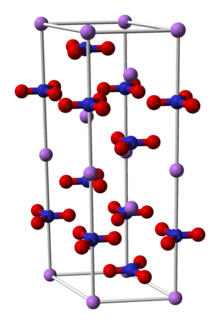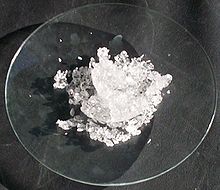
| |
 | |

| |
| Identifiers | |
|---|---|
3D model (JSmol)
|
|
| ChemSpider | |
| ECHA InfoCard | 100.029.290 |
PubChem CID
|
|
| RTECS number |
|
| UNII | |
CompTox Dashboard (EPA)
|
|
| |
| |
| Properties | |
| LiNO3 | |
| Molar mass | 68.946 g/mol |
| Appearance | White to light yellow solid |
| Density | 2.38 g/cm3 |
| Melting point | 255 °C (491 °F; 528 K) |
| Boiling point | 600 °C (1,112 °F; 873 K) (decomposes) |
| 52.2 g/100 mL (20 °C) 90 g/100 mL (28 °C) 234 g/100 mL (100 °C) | |
| Solubility | soluble in ethanol, methanol, pyridine, ammonia, acetone |
| −62.0·10−6 cm3/mol (+3 H2O) | |
Refractive index (nD)
|
1.735[1] |
| Thermochemistry | |
Heat capacity (C)
|
64 J/(mol K) |
Std molar
entropy (S⦵298) |
105 J/(mol K) |
Std enthalpy of
formation (ΔfH⦵298) |
−7.007 kJ/g or −482.3 kJ/mol |
Gibbs free energy (ΔfG⦵)
|
−389.5 kJ/mol |
Std enthalpy of
combustion (ΔcH⦵298) |
25.5 kJ/mol |
| Hazards | |
| Occupational safety and health (OHS/OSH): | |
Main hazards
|
Oxidant, irritant |
| NFPA 704 (fire diamond) | |
| Flash point | Non-flammable |
| Lethal dose or concentration (LD, LC): | |
LD50 (median dose)
|
1426 mg/kg (oral, rat) |
| Related compounds | |
Other cations
|
Sodium nitrate Potassium nitrate Rubidium nitrate Caesium nitrate |
Related compounds
|
Lithium sulfate Lithium chloride |
Except where otherwise noted, data are given for materials in their standard state (at 25 °C [77 °F], 100 kPa).
| |
Lithium nitrate is an inorganic compound with the formula LiNO3. It is the lithium salt of nitric acid (an alkali metal nitrate). The salt is deliquescent, absorbing water to form the hydrated form, lithium nitrate trihydrate. Its eutectics are of interest for heat transfer fluids.[2]
It is made by treating lithium carbonate or lithium hydroxide with nitric acid.
